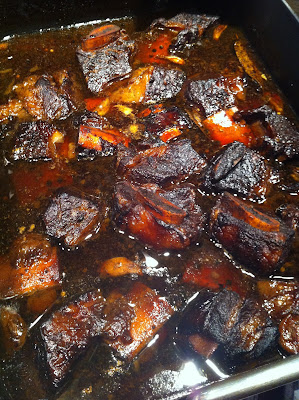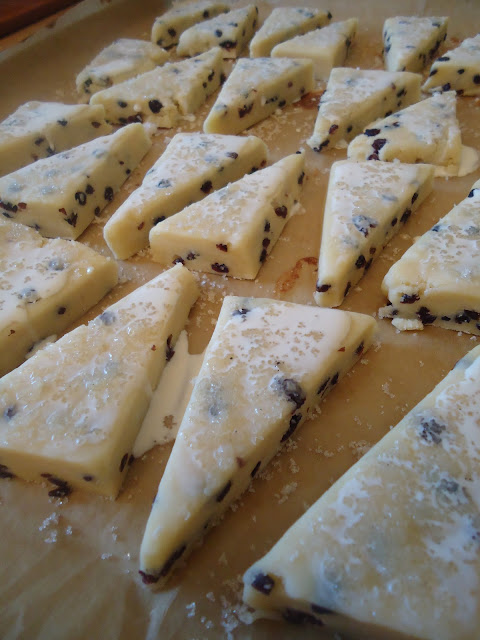Blood Oranges...one of my favorite fruits. I patiently look forward to early winter, here in the US, when these beauties begin to appear at my local super market and farmers market. From about December to April, I use blood oranges as much as possible, even squeezing and freezing the juice for future use throughout the year. Their distinct skin, marked by shades of orange, pink, and red, help them stand out amongst other citrus fruit, begging me to buy them and put them to good use!
Bright orange-to-crimson-red segments are striking when used in salads; blood orange zest added to Lemon Cornmeal Cookies or Citrus Glazed Pound Cake (instead of the lemon zest) adds a new brightness to these simple, classic recipes; and, one of my favorites - add freshly squeezed blood orange juice to enhance your favorite glass of champagne for a new twist on a Mimosa.
But, one of my favorite uses for blood oranges is incorporating them into a traditional flan. Made with eggs and egg yolks, milk and cream, this custard is only heightened with the added caramel that liquefies when cooked and pools around the flan when un-molded and served. The addition of the sweetness and tartness from the citrus plays beautifully with the lightness of the custard, especially with the addition of vanilla beans. And, combining the blood orange juice with the caramel rounds out the entire dessert.
 |
| Blood oranges |
 |
| squeezing fresh blood orange juice! |
 |
| Blood Orange Caramel Sauce poured into bottom of ramekins before adding the Flan custard |
Ingredients:
Blood Orange Caramel Sauce
*1 1/3 C sugar
*1/2 C water
*1/3 C fresh squeezed blood orange juice (strained)
Flan/Custard
*3 C heavy cream
*3 C whole milk
*1/2 vanilla bean, split and scraped
*1 tbsp blood orange zest
*9 whole large eggs
*6 large egg yolks
*1 1/2 C sugar
Preheat oven to 325F.
First things first, get started on the caramel. Combine the sugar and the water in a CLEAN sauce pot. Turn the heat up to high, and allow the water and sugar to come to a boil. Let the sugar and water boil, about 10-12 minutes, until the sugar turns an amber/caramel color.
 |
| beginning stage of melting sugar and water together |
 |
| sugar and water just beginning to boil |
 |
| sugar "bubbles" getting bigger as water evaporates from pot during cooking process |
 |
| sugar reaching amber/caramel color |
 |
| whisking the blood orange juice into the caramel |
While the caramel is setting/hardening, prepare the flan custard. In a large pot, bring cream, milk, vanilla bean (scraped seeds and pod), and orange zest to a simmer over medium high heat. Turn off heat and allow mixture to steep for 10-15 minutes.
 |
| blood orange zest |
 |
| cream, milk, vanilla, and orange zest in pot |
Once egg mixture is ready, add the cream/milk mixture, SLOWLY, to the eggs using whisk to completely combine. Strain mixture through fine sieve to remove vanilla bean pod and orange zest.
 |
| eggs and milk/cream mixture |
 |
| straining the vanilla bean pod and zest from custard |
Pour about 1 cup of the custard mixture over the caramel.
Place baking vessel with ramekins in the oven, and fill a measuring cup with hot water. Carefully pour the water into the baking vessel AROUND the ramekins, trying not to get any water into the ramekins. Fill the water up about 1/2 to 3/4 of the way up around the ramekins. Bake for 30-40 minutes or until completely "set" (meaning when you shake one of the ramekins the custard doesn't move, rather it is SET). Remove baking vessel from oven and allow ramekins to cool slightly.
Remove ramekins from baking vessel and water, dry off bottom, and chill in the refrigerator AT LEAST 12 hours, but more preferably overnight. Make sure to wrap with plastic wrap after an hour of cooling.
When ready to plate, run a knife around the outside of the flan between the flan and the ramekin, and invert the ramekin onto a plate. The flan should gently slide out, and the caramel sauce that once was on the bottom should pour out over the custard and flood the plate.
 |
| Blood Orange Flan with Blood Orange Caramel |
Cheers and enjoy!
































